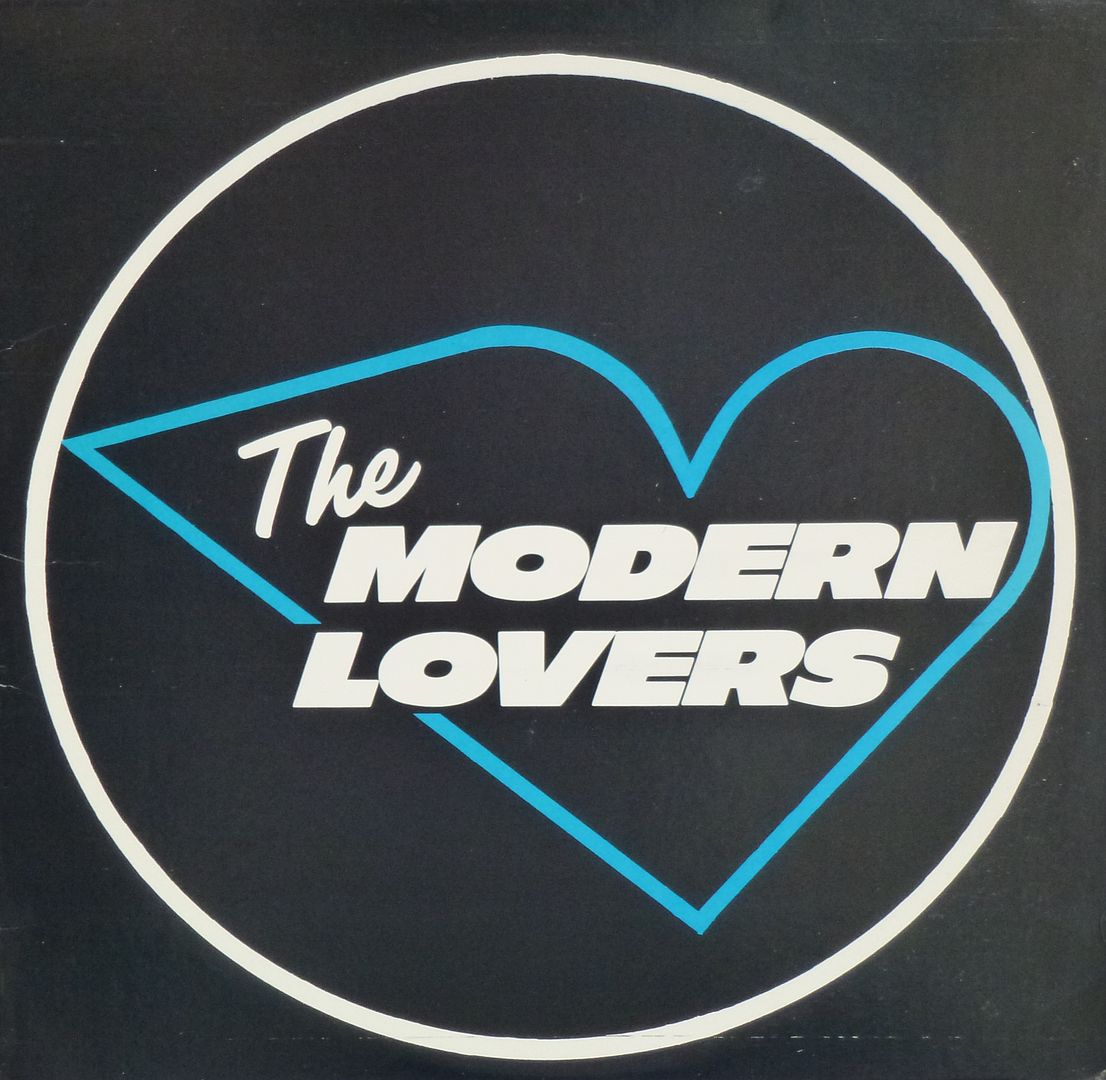
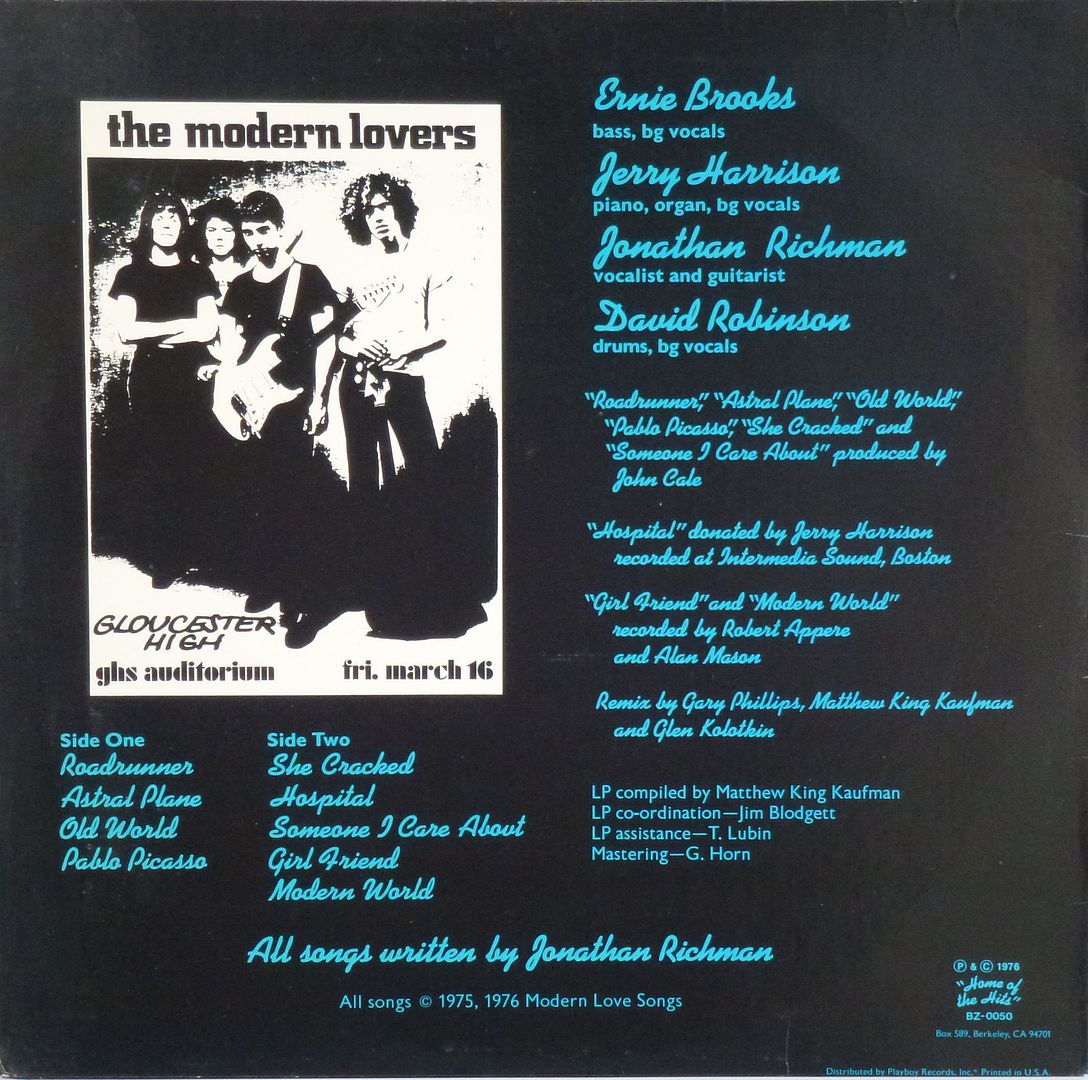
Roadrunner / Astral Plane / Old World / Pablo Piccasso
She Cracked / Hospital / Someone I Cared About / Girl Friend / Modern World
After a little scare of a few days ago when Media Fire suspended my account (in error due to bogus copyright claims) and thankfully restoring it with the minimum of fuss, I can now download an LP just in time for Tony D’s fifty-eek birthday!
Why The Modern Lovers ‘debut’ LP?
Well, not only is it a stone wall classic of 1970’s Velvet Underground inspired rock, the record also features in the very first Ripped And Torn fanzine chart from way back in November 1976 (as did the second Modern Lovers LP at the number one spot). Back in the days before hoards of UK punk records were actually being released, Tony D and Kid Skid, the original duo involved in the production of the fanzine could only listen to, and compile, Ripped And Torn charts with material that was available in the UK. Namely some top notch American vinyl that was as good as it could get in the mid 1970’s, along with the better UK gritty pub rock bands vinyl output. The Damned who had just released the first UK punk 7″ single sneaked in at number two and were also the cover stars for the first issue of the fanzine.

As an additional happy coincidence for this week after the Media fire scare and Tony D’s fifty-eek birthday, it also saw the launch of the official Ripped and Torn website run by Tony D and Gerard who sorts out the technical side of KYPP.
This new website is HERE and is worthy of your support. It displays all the Ripped And Torn issues in full (except issue four that has been lost). Also some interesting articles to look at as well as relevent music from the time hosted by youtube.
Text on The Modern Lovers stolen from the wiki, text on the history of Ripped And Torn in Tony D’s words lifted, but slightly amended, from the new Ripped And Torn website.
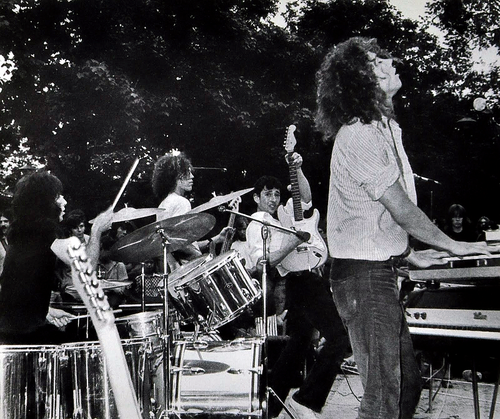
THE MODERN LOVERS
The Modern Lovers were an American rock band led by Jonathan Richman in the 1970s and 1980s. The original band existed from 1970 to 1974 but their recordings were not released until 1976 or later. It featured Richman and bassist Ernie Brooks with drummer David Robinson (later of The Cars) and keyboardist Jerry Harrison (later of Talking Heads). The sound of the band owed a great deal to the influence of The Velvet Underground, and is now sometimes classed as “protopunk”. It pointed the way towards much of the punk rock, new wave, alternative and indie rock music of later decades. Their only album, the eponymous The Modern Lovers, contained stylistically unprecedented songs about dating awkwardness, growing up in Massachusetts, and love of life and the USA.
Richman grew up in Natick, Massachusetts, a suburb of Boston, and began playing guitar and writing songs in his mid-teens, first performing solo in public in 1967. He became enamoured of the Velvet Underground while he was still in high school, and after graduating in 1969, he moved to New York City where he became personally acquainted with the band and on one occasion opened the bill for them. Richman spent a couple of weeks sleeping on Velvets’ manager Steve Sesnick’s sofa before moving into the Hotel Albert, a residence known for its poor conditions.
After nine months in New York, and a trip to Europe and Israel, Richman moved back to his native Boston. With his childhood friend and neighbour, guitarist John Felice, he organized a band modelled after the Velvets. They quickly recruited drummer David Robinson and bass player Rolfe Anderson, and christened themselves “The Modern Lovers”. They played their first date, supporting Andy Paley’s band The Sidewinders, in September 1970, barely a month after Richman’s return. By this time their set list already included such classic Richman songs as “Roadrunner”, “She Cracked” and “Hospital”. Richman’s unique character was immediately apparent; he wore short hair and often performed wearing a jacket and tie, and frequently improvised new lyrics and monologues.
In early 1971 Anderson and Felice departed; they were replaced by Harvard students bassist Ernie Brooks, and keyboardist Jerry Harrison, completing the classic line-up of the Modern Lovers. This new configuration became very popular in the Boston area, and by the fall of 1971, enthusiastic word-of-mouth led to the Modern Lovers’ first exposure to a major label when Stuart Love of Warner Bros. Records contacted them and organized the band’s first multi-track session at Intermedia Studio in Boston. The demo produced from this session, and the group’s live performances, generated more attention from the industry, including rave reviews from critic Lillian Roxon, and soon A&M Records was interested in the band as well.
In April 1972, the Modern Lovers travelled to Los Angeles where they held two demo sessions: the first was produced by the Velvet Underground’s John Cale for Warner Bros. while the second was produced by Alan Mason for A&M. The Cale sessions were later used on the band’s debut album. While in California the band also performed live, and one gig at the Long Branch Saloon in Berkeley was later issued as a live album. Producer Kim Fowley courted the band, traveling to Boston to produce some poor-quality demos in June 1972. Felice re-joined the group for a few months after his graduation, and the band moved together to live at Cohasset, Massachusetts.
The Modern Lovers continued to be a popular live attraction, and on New Year’s Eve 1972 supported the New York Dolls at the Mercer Arts Centre on a bill which also included Suicide and Wayne County. Early in 1973 they were finally signed by Warner Brothers. However, before returning to the studio in Los Angeles to work with Cale, the group accepted an offer to play a residency at the Inverurie Hotel in Bermuda. While there, Richman heard and became strongly influenced by the laid-back style of the local musicians, as documented in his later song “Monologue About Bermuda”. There were also growing personality clashes between the band members.
Although on the band’s return Richman agreed to record his earlier songs, he was anxious to move in a different musical direction. He wanted to scrap all of the tracks they had recorded and start over with a mellower, more lyrical sound. The rest of the band, while not opposed to such a shift later, insisted that they record as they sounded now. However, the sessions with Cale in September 1973 also coincided with the death of their friend Gram Parsons (a former Harvard student, like Harrison and Brooks), and produced no usable recordings. The record company then recruited Kim Fowley to produce more sessions with the band, this time at Gold Star Studios, with better results. Recordings from these sessions with Fowley were later released in 1981 on an album misleadingly titled The Original Modern Lovers.
Following the failure to complete a debut album, Warner Brothers withdrew their support for the Modern Lovers, and Robinson left the band. They continued to perform live for a few months with new drummer Bob Turner, but Richman was increasingly unwilling to perform his old (although still unreleased) songs such as “Roadrunner”, and after a final disagreement between him and Harrison over musical style the band split up in February 1974.
Despite the original group’s premature break-up, many of its members found considerable success elsewhere: founding member John Felice formed the seminal Real Kids, Jerry Harrison later joined Talking Heads, David Robinson co-founded the Cars, and Ernie Brooks would later work with David Johansen, Arthur Russell, Elliott Murphy, and Gary Lucas.
Richman continued recording on his own, eventually moving to California in 1975 to begin working with Beserkley Records whose boss Matthew King Kaufman had met Richman when he worked with A&M. While Richman never returned to the Velvets-inspired sound of the original Modern Lovers, the demo recordings made with that group eventually surfaced in various formats. The first of these releases came in 1976 when Beserkley compiled a posthumous LP from the first two demo sessions produced by Cale and Mason; issued on Beserkley’s Home of the Hits subsidiary, the album was simply titled The Modern Lovers and included celebrated tracks such as “Roadrunner”, “She Cracked”, and “Pablo Picasso”.
Richman did not recognize this compilation as his “first album,” preferring to recognize his debut as 1976’s Jonathan Richman & the Modern Lovers, an album pursuing the lighter, softer direction he had in mind with a completely different band (the two collections were released within months of each other). However, The Modern Lovers was given an enthusiastic critical reception, with critic Ira Robbins hailing it as “one of the truly great art rock albums of all time,” and it influenced numerous aspiring punk rock musicians on both sides of the Atlantic, including the Sex Pistols who covered “Roadrunner” on The Great Rock ‘n’ Roll Swindle.
RIPPED AND TORN
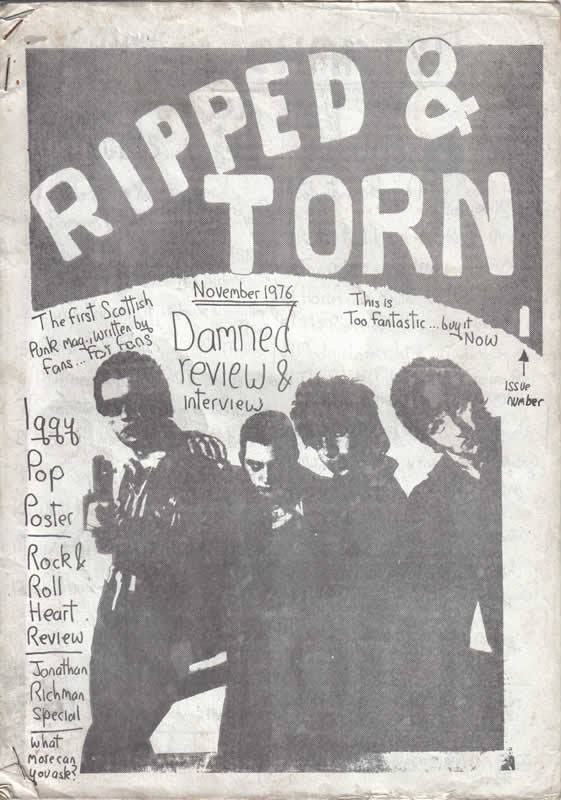
Ripped & Torn was started in Cumbernauld, Scotland by myself and the Skid Kid in 1976 as we wanted to get involved in the punk scene we were reading about in the music papers. There was nothing up in Scotland at the time.
I went to London to see what punk rock was all about. On the first evening I saw The Damned at the Hope & Anchor. Amazing, just amazing.
I had met Mark P and Shane MacGowan earlier and I had seen my first ever copies of Sniffin’ Glue on the Kings Road. Mark P said something like you should start your one fanzine.
Back in Scotland I did. Using a chat I’d had with the Damned as basis of an interview / article about that gig. I was working at an advertising company at the time and used their photocopier to print out ten copies of the ten pages of what was to be the first issue of Ripped & Torn. I sent copies to the music papers, Mark P and also to the shops Compendium and Rough Trade.
Both the shops wrote back each ordering two hundred copies. That was going to be a lot of clandestine photocopying! In the end I went into the printers with my originals and got five hundred of each page printed. I thought the printer would throw me out on my ear or laugh in my face. But he was very sympathetic. This was a whole new experience; I didn’t know that it was possible to do such things. Then of course I had to get the sheets stapled together. This took a few days with a normal stapler (borrowed from work) with piles of paper in the bedroom. The next problem was how would I get the all the copies down to London. It was a steep learning curve but mind-blowing at the same time. There was no guide to help in this, all completely venturing into the unknown.
With the hundred copies left I took them to local record shops in Glasgow; where I learnt about the concept of sale or return. At first the shops took ten copies each. After a week I went back and they all wanted more, having sold those ten very quickly. And I had the rush of seeing a copy in the window, man that felt good. Then there was a piece about Ripped & Torn and myself in the local paper.

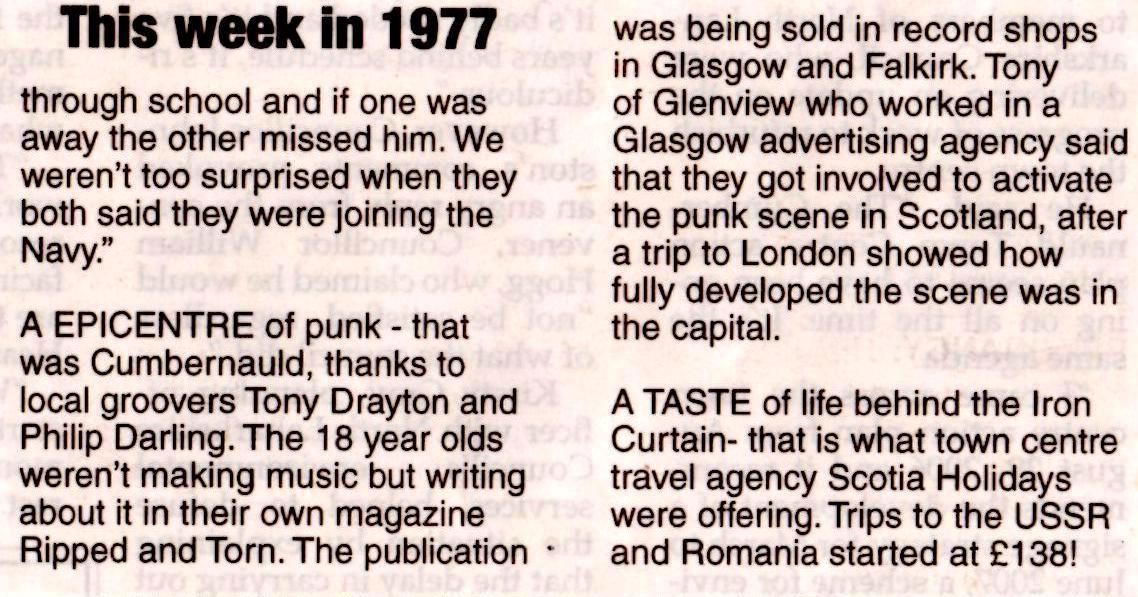
The ball was rolling.
At this time a young Edwyn Collins wrote for Ripped & Torn, and in his book he remembers how disappointed he was to meet me and find out I looked like Noel Edmonds!
This was to change.
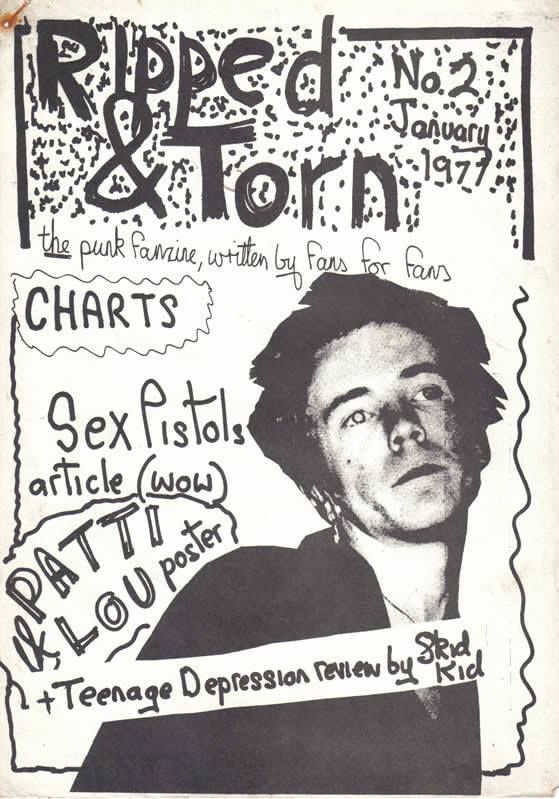
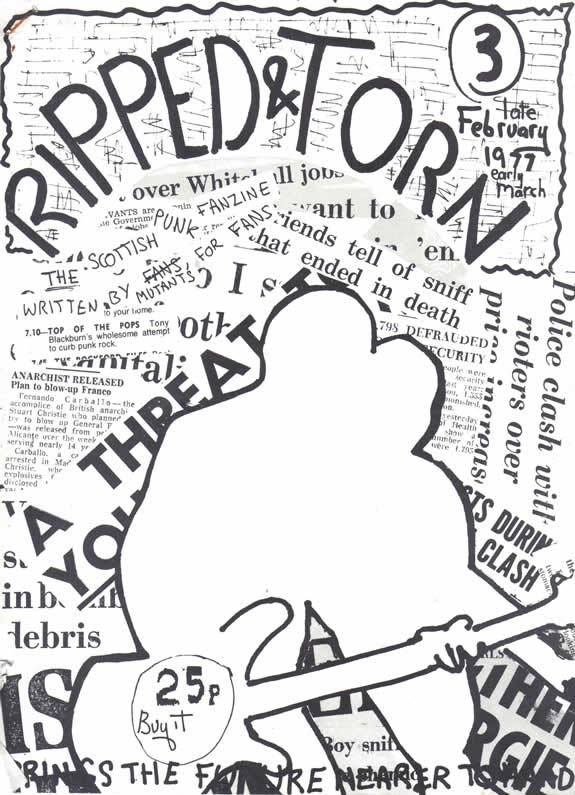
I moved to London with Skid Kid in the spring of 1977, and begun writing Ripped & Torn issue five, which was mainly written in a bed-sit in Willesden Green, then later on that year, from issue seven, the fanzines were written at number 2 Bramley Road which was a squatted pub called the Trafalgar situated within a squatted community known as Frestonia. The Trafalgar pub was also a place occupied by several original Rough Trade shop staff, Steve Montgomery, Jo Slee and Pete Walmsley amongst them. The squat was right next to the infamous ‘Apocalypse Hotel’. Our old friends from Scotland, Sandy Robertson and Alex Ferguson soon joined us in this communial squatted pub to the dismay of the Rough Trade workers. We were collectively known by them as the Scottish plague!
In Ripped & Torn five I had mentioned that Mark P has given up the editorship of Sniffin’ Glue, it folded shortly after. From issue six I am using the same printer as Sniffin’ Glue out in Cambridge, and am typing up the words on the Sniffin’ Glue typewriter in the Sniffin’ Glue office on Oxford Street. Harry Murlowski has set this up. There’s also the first appearance of Step Forward / Faulty Products adverts appearing. Looking at this now I see a big break slipping through my fingers, Miles Copeland – who financed all this office space must’ve been looking Ripped & Torn over as a successor to Sniffin Glue. But I was too snotty to know better.
An even bigger break passed me by when Janet Street Porter came around at the time of the Queens Silver Jubilee procession going past the offices down Oxford Street. She chatted to me and Skid Kid first then spent a long time with Sniffin’ Glue contributor Danny Baker. Shortly after this she got him onto TV and his career rocketed.
I was too busy climbing onto a telephone box to boo the Queens limousine to take much notice of this journalist. And what was a career anyway?
At the same time as all this was happening a strange mood was overtaking the music press – they had begun the ‘punk is dead’ campaign to varying degrees of success. Meanwhile pubs and clubs were bursting with a new wave of punk bands playing to crowds coming to London to find the punk scene they’d read about.
A photographer called Jem Gibbs began sending in photos from gigs he’d been to and they quickly found their way into the pages. Likewise a cartoonist, Phil Smee, began sending in some strange strips about penguins. These also found their way into the next issues. Both elements helped improve the quality of the subsequent issues, and also began to give Ripped & Torn a style and identity. I never met either of these people in all the time of doing Ripped & Torn!
Another thing had happened: Adam And The Ants. This band quickly became the London punks number one band; all the better as the music press despised them and ignored them. It was becoming more and more a ‘them and us’ situation and Ripped & Torn was in a great place to get in amongst it. Ripped & Torn had the first ever Ants interview printed in issue eight published in September 1977.
As the punks kept pouring into London, squatting began happening on an ever larger scale. I remember walking from an Ants gig at the Roundhouse in Camden down Tottenham Court road and installing into the derelict flats on Charing Cross Road a whole load of homeless punks who happened to be at the same gig. A few weeks later they’d spread throughout the whole block!
Around the end of 1978 things began to change dramatically. Crass appeared and with them a complete re-focusing of the punk ideal. Johnny Lydon appeared with PIL in a Xmas show where his cynicism and mocking of the audience touched the wrong note with me.
The last issue of Ripped & Torn I was involved with was issue seventeen which is dated March 1979.
At that time I had moved out of Frestonia and into a large squatted complex in Covent Garden, an interlinked series of shop fronts, warehouses and rooms that stretched around James Lane and Long Acre. Shrink was on the cover of this issue, and was actually the catalyst of the move.
I’d gone to the Rock Garden to see Shrink play, been impressed and arranged to interview him for the next issue. Then a girl at the gig invited me to a party in her squat round the corner in Long Acre. I went, and even though I found out the ‘party’ was just me and her, I moved in with her. A week later Skid Kid also moved in, finding solace in the arms of the lead singer of a band called Bitch who lived on the top floor. She encouraged him to develop his bass-playing skills and shortly they both moved out of the squat and went on to form a psychobilly band together.
I discovered shortly after arriving that the squatted complex I’d moved into was in turmoil; probably the turmoil allowed me and Skid Kid to move in no questions asked, but the turmoil also led to the place getting evicted.
Most of the material that was eventually to be found in Ripped & Torn seventeen was put together in the front room of 48 Long Acre, although some of the material must have been written and laid out in the transition between entering the squat and being evicted as there is a note scribbled on the back cover saying how we are homeless and need somewhere to put the fanzine together!
An advance party from the Long Acre and James Street squats had recently found and moved into a disused fire-station near Old Street; we all drifted across throughout that spring. I wasn’t feeling very much like writing, and there wasn’t the time: on the back of Crass there was a renewed explosion of fanzines – a whole new scene was beginning that became known as Anarcho Punk.
But I was thinking further afield and I had a headful of hippy trails and thought of just bumming around Europe. In the basement of the squatted Trafalger pub in Frestonia were stored large collections of hippy magazines and I read my way through just about all of the Oz and International Time magazines that were in that basement during my stay there throughout 1977 and 1978.
Vermilion had arrived in London, a writer and musician from San Francisco who had connections to the infamous City Lights bookshop and related journals from there. She had also got in with the Step Forward Records crowd – who used to help keep Ripped & Torn afloat with their advertising.
Living transiently at the Fire Station I realised that I may as well live transiently abroad and got a cheap bus to Paris. Before I went I arranged with Vermilion to take over running of Ripped & Torn, rather than let it die I thought she might be able to give it a new spark and take it in a professional direction.
The squatting life had caught up with me and the fanzine had never been run properly as a financial business, or even as any kind of business. I mainly sold review copies of records to raise the cash to pay for printing, and then take armfuls of them around gigs selling them as I went.
There were a few shops along the Kings Road and Rough Trade of course, a few people attempted and failed at distributing them; so Vermilion was a bit surprised – shocked even – when we met to hand over the Ripped & Torn ownership I only gave her a handwritten list of subscribers (their subscription money had been spent long before) and a list of a few shops and how many they took – sale or return. One of the problems with distribution was the irregularity of the issues.
Upon my return from Europe about two months later, Vermilion had produced one issue, the most professional and well printed issue of the whole Ripped & Torn collection, with a great piece by Genesis P Orridge; I had nowhere to go so turned up at the Old Street Fire Station to see if it was still squatted. To my surprise it was now a punk rock commune. From this base I thought about producing a new fanzine and eventually this idea was followed through with the eventual printing help of Better Badges who worked on the last fine issue of Ripped & Torn.
That fanzine was to be known as Kill Your Pet Puppy.
TONY D
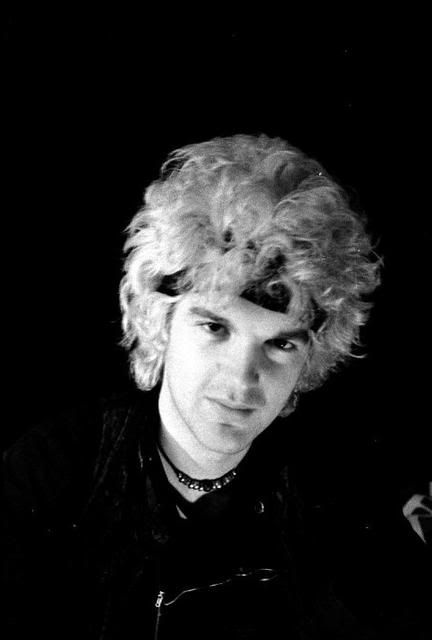
HAPPY BIRTHDAY TO TONY D – FOUNDING FATHER OF RIPPED AND TORN AND KILL YOUR PET PUPPY FANZINES FROM ALL THE OTHERS HERE AT KYPP ONLINE

Tony Puppy
April 13, 2012 at 10:22 pmPenguin I’m touched. You’ve really tidied up those R&T words I wrote. And to hear the Modern Lovers song ‘Hospital’ again is sublime.
Steve
April 13, 2012 at 10:25 pmGreat stuff! Of course what we really need is a book-length memoir HINT HINT…
Carl
April 13, 2012 at 10:45 pmTony, at which point did you look like Noel Edmonds ????
gerard
April 14, 2012 at 9:20 amhttp://rippedandtorn.co.uk/wp-content/uploads/2010/12/Cumbernauld-News-pic1.jpg
Deal or no deal?
AL Puppy
April 14, 2012 at 1:20 pmGreat read. It is an alternative history of punk.
baronvonzubb
April 14, 2012 at 4:16 pmive got the radio on.
and no it aint some net based dubstep (although cockney vioilin is sort of listenable to….)
its r4 😉
anyone know if theres a KYPP may meet up this year ?
dan i
April 14, 2012 at 5:50 pmGood stuff. I checked out the site – great to be able to read the zines and some cool vids too.
Carl
April 15, 2012 at 7:59 amCrikey Gerard, that picture does have the look of a 1970’s radio dj !!!!
Nic
April 22, 2012 at 5:33 pmA fascinating insight into an inspirational trajectory, and great news that the R & T website is up! Many Happy Returns to Tony…